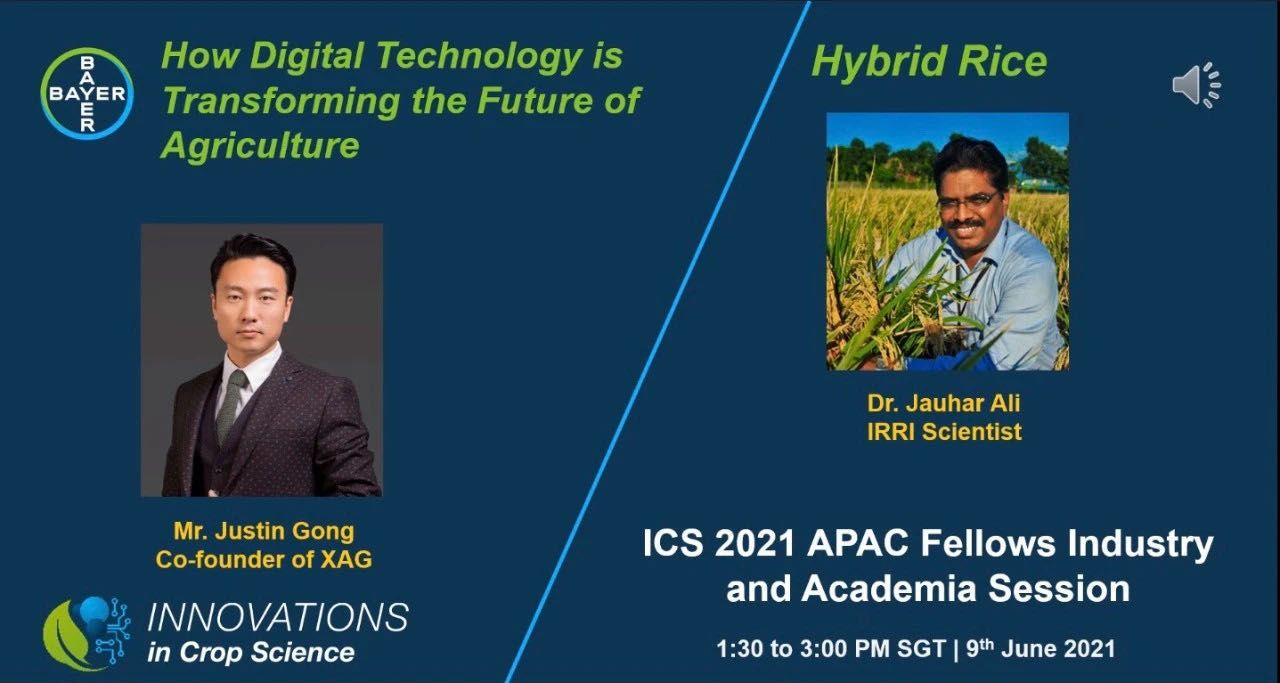- Home
-
Products
- News
- About
- Become a Distributor
Global - English

When we order food on the APP, big data and AI can help delivery men plan the most efficient delivery routes. On the highway, a car with autopilot AI can help drivers see what is on the road to ensure the safety of passengers. And now these new technologies also start to shine in the field of agriculture. Then you may wonder: can robots and AI actually work to ensure we have safe, nutritious food for tomorrow's table?
At on June 6, Justin Gong, Co-founder of XAG, was invited to share the answers at Bayer Innovation in Crop Science (ICS) Global Conference, providing a speech on how digital technology is transforming the future of agriculture. ICS is an annual internal festival of Bayer Crop Science for its scientists to spark new ideas and exchange experiences. XAG and Dr. Jauhar Ali, Research Unit Leader of International Rice Research Institute are two special guests at the External Speaker Session.

From manual to AI control
According to Justin Gong, XAG focuses on the development of robots and AI to empower agriculture for a food-secured future. From 2014 to 2020, the company had witnessed two major transformations on its agricultural drone technology and distribution model.
"In 2014, when XAG designed the first generation of crop protection drone, it could only be remotely controlled by radio to spray field crops. Then the drone made its upgrade into semi-auto control from 2017-2019 that can conduct both liquid spray and granular spread. Until 2020, our latest agricultural drone has become an AI-controlled platform with three-in-one design. This means that the pilots can simply operate it with smartphone, while the drone flying autonomously to survey the fields, spray crops, and broadcast seeds," said by Justin Gong.

XAG drone pilot provided crop spraying service in 2016
In terms of the change on distribution, the first step was to resolve farmers' concern over new technology. At the beginning, XAG established drone pilot teams in China to provide crop spraying service directly to farmers, which proved the performance of drones against pests and diseases. Now in response to the burgeoning market, a global sales network of agricultural machinery dealers has been set up to provide training and maintenance services, as well as promoting smart agriculture concepts to farmers.
Drone is not enough
Labour shortage, food insufficiency, overuse of pesticides, and decreasing food diversity are four major challenges facing the world’s agriculture system. As Justin Gong Introduced at the conference, XAG has developed the three-pillar smart agriculture solutions going beyond the application of drones. It not only empowers farmers with more efficient tools to improve crop yield and raise their income, but also helps reduce chemical use in food production and restore the degraded wetlands.

XAG Smart Agriculture Solutions
"Specifically, we use remote sensing drone to create digital field maps for farmers and build a high-accuracy navigation network in the farmland. So that XAG's agricultural drones and unmanned ground vehicle can automatically plan the route and take on precision farming operations to cut down labour cost, while largely decreasing the use of pesticides and fertilisers," Justin Gong said.
The third pillar of XAG's solution is to create an autonomous agriculture ecosystem. The Smart Farm Management Platform can analyse crop growth and climate conditions, helping farmers make data-driven decisions on when to seed, where to spray, and how much inputs are required.

XAG female drone pilots
Up to December 2020, there have been 66,340 XAG unmanned agricultural devices put into operation across 42 countries and regions. Their service record reached 52 million hectares of farmlands, with 78% end users are smallholder farmers. Without mechanical damage on crops caused by tractor use, the scaleup of drones and robots has been closing yield gap for food producers. Rural women are also empowered with equal access to high tech and modern agriculture training.

XAG R150 unmanned ground vehicle conducted disinfection in Thailand
As it expands into the global markets, XAG will collaborate more closely with users, government, and businesses to catalyse change in the future of food and agriculture.